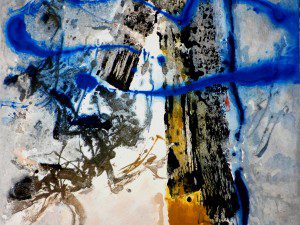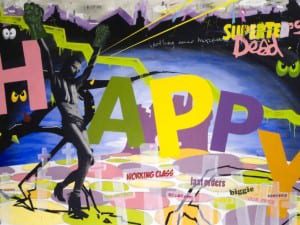Over the past 30 years, New Zealand-based Judith Cordeaux has developed a vocabulary of pictorial motifs in her paintings. These include mundane everyday images (steps, washing on a clothes line or small houses), fantastical creatures, as well as symbols such as hearts, clouds and rain. These are not used in a conscious way; they materialise as a work progresses, in response to the subject matter.
A: Why do you think that your works translate as a “pictorial motif”?
JC: Having played music most of my life – and studied violin very seriously – I am always aware of harmonic and melodic motifs, those little musical ideas or fragments, that recur throughout a composition. They can become characteristic of a composer’s larger body of work. For example, when you hear the opening of a piece of music, you can often guess or identify the composer within a few “sound bites”, just from the harmonic or fragmentary motif that occurs. When I talk about motifs in relation to my art, I usually mean it in this sense – a vocabulary of images and symbols that have developed over many years. As a visual artist, I often use these to give a voice to my thoughts and feelings. There are also several overlying very large motifs to my works – a concern for the treatment of women in all societies, freedom (of mind as well as body) and, especially, the power of love.
A: How do you think that abstraction works within the compositions?
JC: We are exposed daily to such a multitude of graphic images through television and other photographic media that in the end not much really registers. It’s like eating a takeaway, a fast food meal. I think that abstraction from pictorial realism can prompt the viewer to take a moment (or hopefully longer) to figure out what may be happening and in so doing, to think about the issues raised. It is important to stimulate the viewer’s imagination, their visual taste buds as it were – not just instant gratification. My Wild Sea and Sea Music series are among the most abstract of my work to date. They express the sounds and energy and power of the ocean, uncontrolled by human actions.
A: Are you interested in colour theory or the deconstruction of ideas?
JC: The reaction to colour is very much culturally influenced, so it would be arrogant to assume that my use of colour is going to have the same meaning for everybody. I have my own emotional reactions to, and associations with, different colours, and viewers will have theirs. And that’s fine. The same with the “deconstruction of ideas” – these terms are of more concern to the art critic or the conceptual artist than to me. I think it is a truism anyway – of course there is not one single intrinsic meaning in a work of art but many, sometimes conflicting.
A: Why do you think that the concept of the everyday is interesting in terms of subject matter as well as wider metaphors and intangible ideas?
JC: When people see something they recognise in a seemingly abstract painting, something that relates to their everyday life and experiences – it might be an ice cream or a line of washing or a flower – it encourages them to look further, and then to think about what they see. It’s like journalism – if you don’t hook the reader in the headline or the first sentence, you’ve lost them forever. And sometimes people find more in my paintings than I realised was there!
A: How do you think that you create a balance between these contrasting ideas and why is this important to you as an artist?
JC: I think I’m quite a literal person. Also I remember an art tutor at university telling me that the medium should relate to the message. For example, you wouldn’t use soft water colours to depict a spiky thistle. When I wanted to talk about the scarring inflicted on women’s bodies through medical procedures or abuse, and the derision we suffer as a result (being called an “old bag” as a mild example), I used old used wool sacks, with their rips and slashes, stretched and cobbled-together sections, as my canvas. I then added various abstract images such as the scar and stitch motifs, as well deploying the vibrant colours we often use to disguise – or maybe defy – our realities. Similarly, the Children’s Games and Daze of Our Lives series used child-like, fantasy images and the bright primary colours favoured by children. These series have a particular influence and resulted in the development of many of my motifs over recent years, and can be seen in the paintings recently shown in New York, Milan and London.
A: Your latest series is included in a solo exhibition at Aigantighe Art Gallery, Timaru, this September. What is the inspiration behind this series?
JC: It is seven years this September since the first of the devastating earthquakes struck Christchurch, in New Zealand. They literally turned my world upside down, and in the ensuing months, especially February 2011, they destroyed much of what I loved – my home and my adopted city where I had lived for nearly 50 years after moving from Australia. The paintings and drawings I am working on depict my initial reactions, and then the aftermath. In my case I have been fortunate to be able to eventually rebuild a new life, but for many others the struggle with insurers and builders continues. My new works talk not just about the destruction and difficulties, but also about the unconditional love and kindness experienced from friends, neighbours and strangers as we all dealt with this life-changing situation.
A: How are these works different to some of your previous pieces?
JC: I think rather that they are a continuation and a development, using what is now a mature vocabulary. Perhaps the major difference is that the subject matter could be seen as even more universal and encompassing – the earthquakes affected young and old, rich and poor, male and female. I think it also gave us as New Zealanders a better understanding of the traumas being faced daily by ordinary people in other countries devastated by natural disasters and war. We now understand the look in their eyes.
A: What are your aspirations for future developments in terms of your creative career?
JC: I don’t know where this great adventure will take me next! We are all creative beings and I just keep creating, painting – sharing my thoughts and feelings with anyone who stops to look.
Credits:
1. Judith Cordeaux, Balancing Act (2017). Courtesy of the artist.





